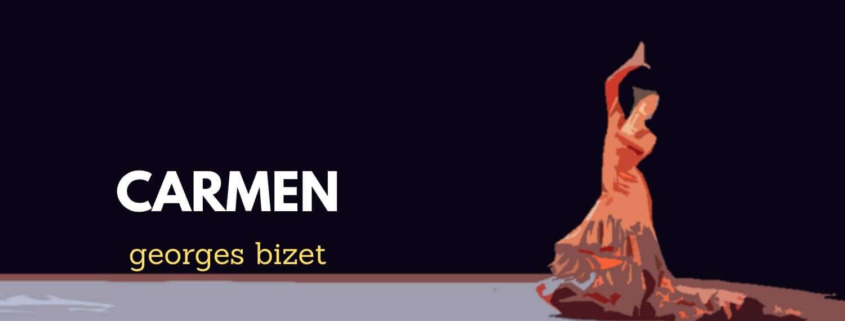The Portrait of Bizet’s Aria LA FLEUR QUE TU M’AVAIS JETÉE
Read Interesting facts and hear great YouTube Videos about the famous Aria “La fleur que tu m’avais jetée”.
If you want to hear more about the opera Carmen, click on the link to the opera portrait
The Aria – Synopsis & Background
One of the most beautiful arias in opera history is the so-called flower aria, «la fleur que tu m’avais jetée».
Synopsis: Carmen wants José to join the smugglers. She tries to persuade him in the smuggler tavern, but José wants to lead an honest soldier’s life. Carmen is disappointed by so little courage and mocks him. José swears his love to her and reminds her of the flower she threw at him.
There is a lot of psychology in this aria. Abbate/Parker: «The aria is introduced by a ghostly orchestral flashback, with the recurring theme being played by the English horn, as if this instrument were to be established as a tamed force … With the words «Et j’étais une chose à toi», provided by Bizet with the instruction ‘pp rall e dim’, José swings to a high B and keeps it long and incredibly quiet. It is a moment that strongly reminds us of the end of «Celeste Aida». Now the voice sounds as if it had been sucked into another sphere. José is so fascinated by Carmen that he dives into her musical world.»
There are some passages that stand out in this aria. Already in the opening of the aria Bizet composes the beginning “La fleur” offbeat. You can find an interesting explanation of this in the commentary on Jussi Björling’s video below. Another passage is the “Je m’enivrais”, where the tenor must depict the memory of the flower-scene delicately but richly. An important highlight is the “Te revoir, ô Carmen, oui, te revoir! Car tu n’avais eu qu’à paraître ” which must be sung with desperation until total submission at the point “Et j’étais une chose à toi”, which the tenor, exhausted, whispers without orchestral accompaniment. The piece concludes with the imploring high “O Carmen je t’aime”. A heroic high note would not be appropriate here, even if it were more spectacular.
The Aria – the text of LA FLEUR QUE TU M’AVAIS JETÉE
La fleur que tu m’avais jetée,
Dans ma prison m’était restée.
Flétrie et séche, cette fleur
Gardait toujours sa douce odeur;
Et pendant des heures entiéres,
Sur mes yeux, fermant mes paupières,
De cette odeur je m’enivrais
Et dans la nuit je te voyais!
Je me prenais à te maudire,
À te détester, à me dire :
Pourquoi faut-il que le destin
L’ait mise là sur mon chemin?
Puis je m’accusais de blasphème,
Et je ne sentais en moi-même,
Je ne sentais qu’un seul déisr,
Un seul désir, un seul espoir:
Te revoir, ô Carmen, oui,
te revoir!
Car tu n’avais eu qu’à paraître,
Qu’a jeter un regard sur moin
Pour t’emperer de tout mon être,
Ô ma Carmen!
Et j’étais une chose à toi
Carmen, je t’aime!
Vocal Fach «Spinto Tenor»
The role of Don José is written for a spinto tenor (Italian) respectively young heroic tenor (German). The voice is strong and masculine. It has a metallic brilliance in the high notes. It captivates with its effortless power in the higher tessitura and has still agility. In the high register the Spinto Tenor can inspire the audience with top notes.
Famous interpretations of La fleur que tu m’avais jetée
We start with Jussi Björling Interpretation. The comment is from the book “The Björling Sound: A Recorded Legacy”
“Björling unhesitatingly attacks the opening high F, a note that coincides awkwardly with the tenor’s register break. Bizet of course was entirely aware of this; his intention was to make the tenor sound emotionally exposed right from the beginning. He sings the word «fleur» (marked «con amore» in the score) too loudly and fails to caress this keyword. He does, however, shape this phrase with a tenderness that was uniquely his own. The bitter recollection («Je me prenais à te maudire») lacks the biting accents, but the subsequent transition to A-flat major is handled with unusual suavity. The fortissimo climax on «te revoir, o Carmen» is superbly managed with a melting legato and with rhythmic urgency. Although he eschews the written diminuendo in the ascent to the top B-flat – a note that once again exposes José’s emotional vulnerability – his forte high note is of such concentrated beauty that the emotional tension is released.”
La fleur que tu m’avais jetée (1) – Björling
Next Placido Domingo.
La fleur que tu m’avais jetée (2) – Domingo/Solti
Next is Vickers, the canadian Tenor, famous for his Wagner.
La fleur que tu m’avais jetée (3) – Vickers/Karajan
And a fourth version with Jonas Kaufmann, a brillant Don José. As Kesting says: “Kaufmann is the ideal cast for broken characters as for example Don José”.
La fleur que tu m’avais jetée (4) – Kaufmann
Peter Lutz, opera-inside, the online opera guide to the Aria la fleur que tu m’avais jetée from the opera Carmen.




Leave a Reply
Want to join the discussion?Feel free to contribute!